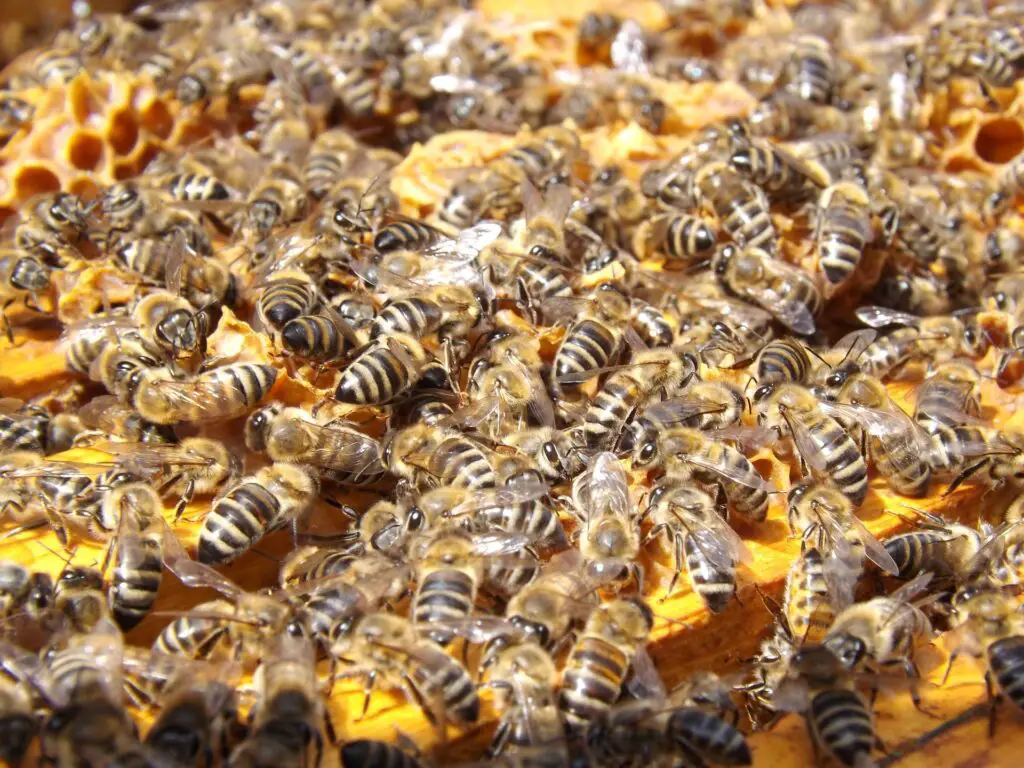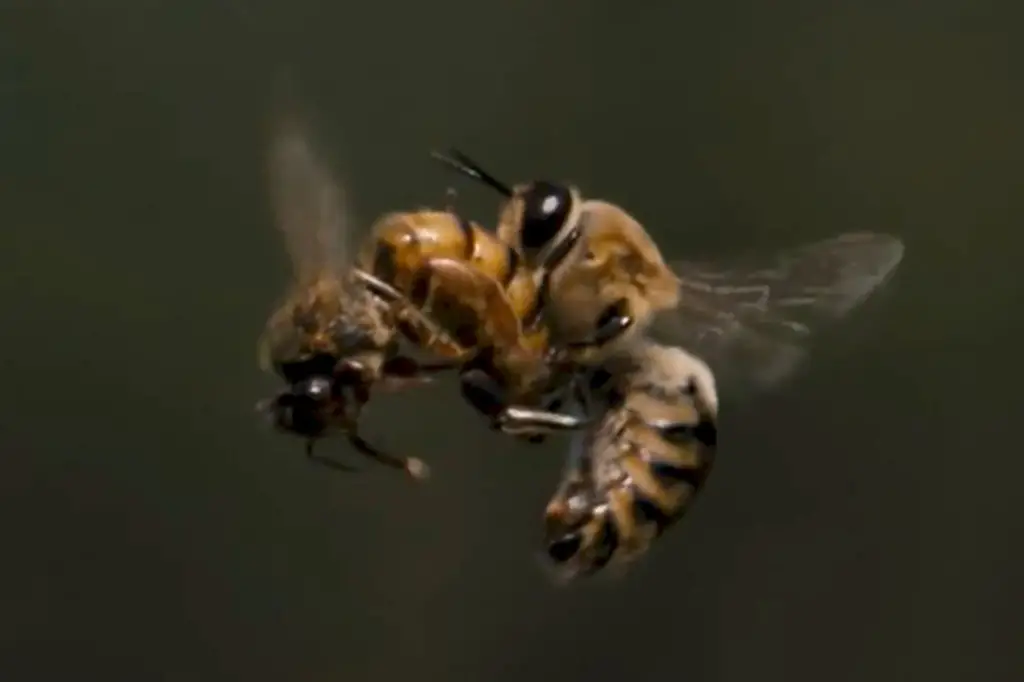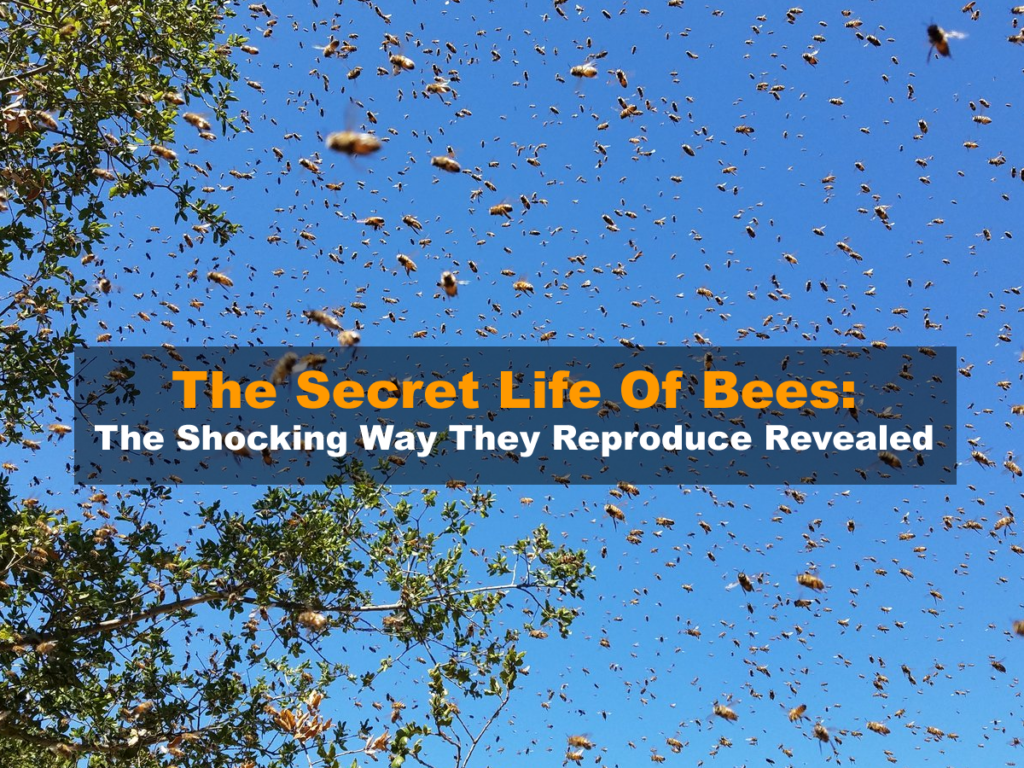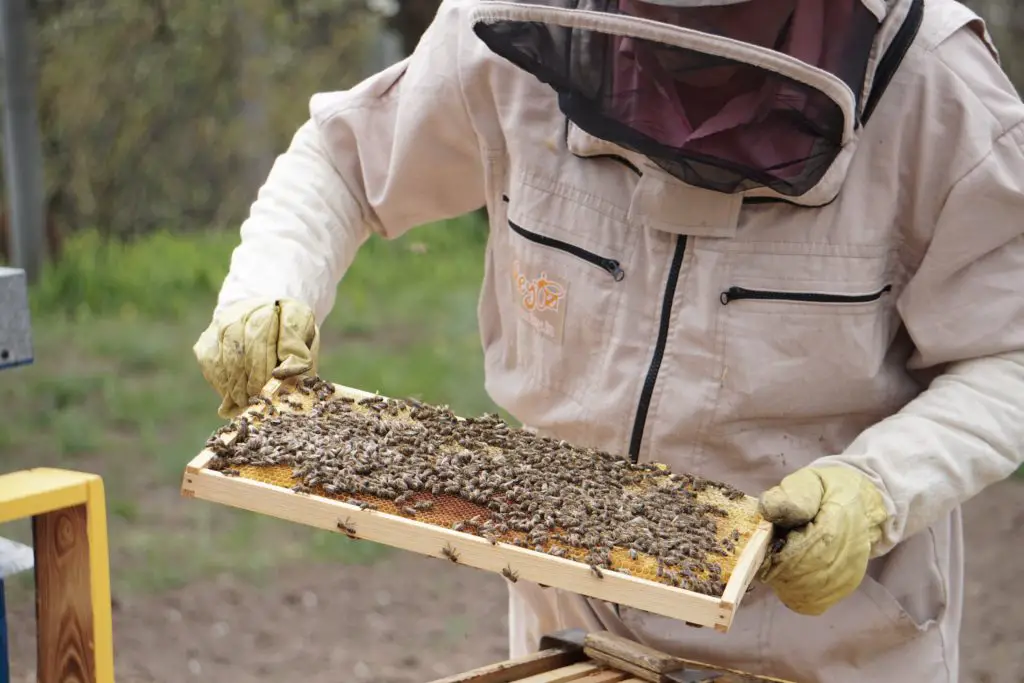Affiliate Disclaimer - As an Amazon Associate I earn from qualifying purchases.
It supports the website. So, Thank you
Bees may be one of the smallest creatures on the planet but they’re also one of the most important. These flying critters are responsible for 80% of the pollination of human crops and according to one author, man would only survive four years if the bee population were to go extinct.
So, it goes without saying that bee reproduction is essential not only in their survival but seemingly, our own. So, how do bees reproduce?
The way that bees mate largely depends on their species, but most mate whilst airborne and often a mating flight is involved between the Queen Bee and the Drones who will eventually mate with her to produce new larvae for the hive.
Let’s take a closer look.
Table of Contents
Different Types Of Bees And How They Mate
For the purposes of this article, I want to focus on the honey bee. However, there are 20,000 bee species on this planet so let’s quickly explore how some of them reproduce.
Bumblebees have a pretty aggressive mating technique whereby the male will tackle the queen to the ground in order to climb on top of her and mate.
In carpenter bees, the males show a little more decorum and impress the females with a dance. Typically, there could be up to 12 males trying to impress a small group of three or four females. Since the bees must be airborne in order to successfully mate, the females will take flight when they are ready to accept and it’s then up to the male to attempt to climb onto them.
Where sweat bees are concerned, the mating rituals are quite similar to that of the honeybee. However, in this case, the bees don’t engage in a mating flight and females only tend to lay eggs if there’s a real need to expand the community.
But potentially the most interesting type of bee reproduction is the cape bee. There has been scientific research taking place to observe the behavior of these bees and it’s been noted that some females are able to reproduce asexually. In order to do this, they must escape the queen and take control of the colony. Research has shown that a special gene is responsible for these bees’ ability to reproduce this way.
The Reproduction Of Honey Bees
One of the things I notice time and again about honey bees is how everything they do is ritualistic and organized. There’s nothing left to chance and you’d be hard-pushed to find a colony behaving haphazardly. These are incredibly regimented creatures and the same can be said when it comes to their mating patterns.
When Do Honey Bees Mate?
It is biologically possible for a queen bee to lay eggs at any point during the year but it’s far less likely that they’ll do this unless the conditions are right. Generally speaking, bees will only lay eggs during warmer parts of the year.
When the weather gets colder, bees will cease reproducing in the same way that many of their other activities slow down and the hive goes into a more dormant state. At this point, the food sources run low since the bees are unable to produce as much. They will gather nectar and pollen throughout the warmer months and store this to feed the colony over winter but it’s always a push. This means that a lot of the older members of the colony begin to die off.
When spring rolls around, there is a whole new generation of bees and the workers are busy preparing the next queen. Throughout spring and summer, the reigning queen will mate many times.
Honey Bee Anatomy
Honey bees come in various types and this essentially refers to their role within the colony. But this role also determines the reproductive anatomy of the bees.
Worker bees are always female. They have ovaries but their reproductive system isn’t active. In most cases, these worker bees won’t even develop any eggs and their main responsibility is taking care of larvae, gathering food and other things.
Drones are the males of the colony and they do have active reproductive systems which they use to mate with the queen.
The queen’s main job is to repopulate the colony so it goes without saying that her ovaries and reproductive system are in full working order. It’s possible for a single queen to lay hundreds of thousands of eggs throughout the course of her life!

Honey Bee Mating
When mating, honeybees are unable to do this on the ground. Instead, they need to be at least twenty feet above it and will engage in what is known as a mating flight. The benefit of this is that, when in the air, the queen has much easier access to several drones. Plus, the drones are able to put on a spectacular display to impress the queen.
The first time that a queen mates may be no more than a week after she is born. But since honey bees start preparing queens from the second they hatch, it’s something she’s well prepared for. During this time, she will need to practice for her mating flight and do ‘trial runs’ to increase the strength in her wings. If she doesn’t do this then she won’t be able to stay in the air with a drone attached to her.
Once she is prepared, the queen will head to the area where the drones are gathered. They wait patiently for the queen to arrive. While mating takes place relatively close to the hive, it’s more likely that the queen will choose a spot a little further away, typically within about two to three miles from the hive.
When mating, queen bees don’t just choose one or two partners. In a single mating flight, a queen can mate with multiple drones. Usually, these flights last for around half an hour and since mating takes just seconds, it’s easy to see how many drones she can copulate with. However, she’ll only mate with each one once.
What’s interesting is that after each drone has mated with the queen, it will leave a small piece of its reproductive parts attached to her; this is called a mating sign. When the next drone comes along, he has to remove this in order to take his turn.

Is It True That Male Bees Die After Mating?
Mating is the main reason for the existence of drones. So, their life will come to an end once they have successfully mated. This is the case in many species across the animal kingdom, especially in insects.
This is because of the mating sign. When he mates, the drone leaves a part of his reproductive system in the queen and this is the loss of a body part, which, as with anything else, would kill an animal.
However, if drones are unable to successfully mate, then they are often kicked out of the hive and left to fend for themselves which never really goes too well.
How The Queen Lays Eggs
Queen bees are able to lay both fertilized and unfertilized eggs. The unfertilized eggs are released without any sperm and these turn into drones. However, fertilized eggs make female bees. Unlike in human reproduction, sperm behaves a little differently in bees and it plays an important role in keeping a balance between the male and female population of the hive.
When it comes to deciding between laying fertilized or unfertilized eggs, both the queen and the worker bees will work together. The workers will build honeycomb cells for the queen to lay eggs in. If there is a need for more drones, the workers will make slightly larger cells and the queen knows only to lay drone eggs here.
How Long Do Honey Bees Live?
The lifespan of a honey bee really depends on the type of honey bee we are talking about. For example, drones have the shortest lifespan as their main purpose of even being alive in the first place is to reproduce. Once they have done this, it’s game over and even if they don’t, they’ll only get ostracized from the hive once winter arrives and that’s something else they won’t survive.
Worker bees can live up to around seven weeks of age but some don’t even make it to six weeks old. It really depends on when they are born as those that hatch in busier periods will have to work harder and this shortens their lifespan. Plus, if we’re talking about winter bees, these can live up to six months in the right conditions and when they have enough fat stores. In the earlier days of their lives, worker bees are used to take care of larvae. However, as they get older, they start going out of the hive to forage and this puts them under a lot of physical stress.
Finally, there is the queen bee and she has the longest lifespan of all honey bees. In some cases, queens can live for several years provided she is able to avoid things like disease during their mating flight. Once the mating flight has been completed, queen bees will return to the hive and remain there for the rest of their lives.
Final Thoughts
Bees are amazing creatures that, while small, show real signs of organization and intelligence. This extends to their mating rituals which are played out in perfect sync with the weather, the age of the queen and the individual jobs of each member of the hive.
If you’ve ever wondered ‘how do bees reproduce’, now you know. So, next time you see a swarm of bees buzzing around in warm weather, there’s a good chance that they’re in the process of starting a whole new generation for their colony.




